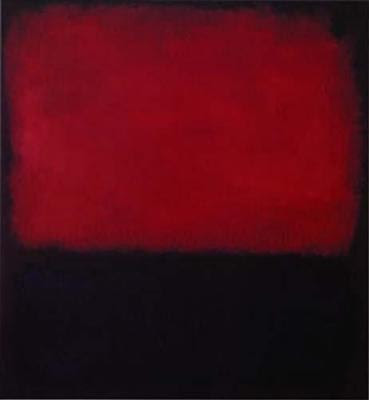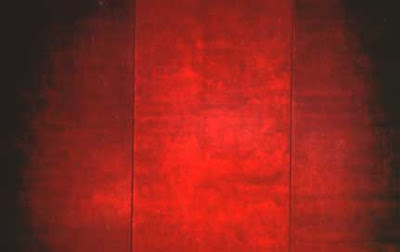"One morning in the spring of 1970, I went into the Tate Gallery and took a wrong, right turn and there they were, lying in wait. No it wasn't love at first site. Rothko had insisted that the lighting be kept almost pretentiously low. It was like going into the cinema, expectation in the dimness. Something in there was throbbing steadily, pulsing like the inside of a body part, all crimson and purple. I felt I was being pulled through those black lines to some mysterious place in the universe. Rothko said his paintings begin an unknown adventure into an unknown space. I wasn't sure where that was and whether I wanted to go. I only know I had no choice and that the destination might not exactly be a picnic, but I got it all wrong that morning in 1970. I thought a visit to the Seagram Paintings would be like a trip to the cemetery of abstraction - all dutiful reverence, a dead end. Everything Rothko did to these paintings - the column-like forms suggested rather than drawn and the loose stainings - were all meant to make the surface ambiguous, porous, (and) perhaps softly penetrable. A space that might be where we came from or where we will end up. They're not meant to keep us out, but to embrace us; from an artist whose highest compliment was to call you a human being."
BBC: http://www.bbc.co.uk/arts/powerofart/rothko.shtml
Rothko reached his mature style around 1949 and the early nineteen fifties. Rothko’s work features “large hand-shaped rectangles, usually staked one above the other, together filling nearly the entire field of the canvas”, with each rectangle having “slightly different hues, while the background color (sic) differs only a little more from that of the rectangles” (Kostlanetz, R., 2001 p.530). Rothko’s work can be seen as an important precursor to monochromatic painting that we have seen since the nineteen sixties and seventies, which explore “surface tensions, color (sic) relationships and ways of negating suggestions of ‘depth’” (p.530).

No 14, 1960.
Rothko was part of the “theological” wing of the abstract expressionists. He was “obsessed with the moral possibility that his art could go beyond pleasure and carry the full burden of religious meanings- the patriarchal weight, in fact, of the Old Testament” (Hughes, R., 1991 p.322-323). His attempt to fulfil this ambition culminated in a series of paintings from 1964-7, commissioned by the de Menil family as “the objects of contemplation” in a non-denomination chapel attached to Rice University (p. 323).
 Centre Tryptich for Rothko Chapel, 1966, Houston
Centre Tryptich for Rothko Chapel, 1966, HoustonThe monochromatic paintings have “all the world…drained out of them, leaving only a void”: the Rothko Chapel therefore represents "the last silence of Romanticism” (Hughes, R., 1991 p. 323).
Bibliography:
Hughes, R., (1991) The Shock of the New, London: Thames and Hudson.
Kostelanetz, R., (2001) Dictionary of the Avant-Gardes, New York & London: Routledge.
Schama, S. & BBC, Simon Schama on Rothko: Available from World Wide Web: http://www.bbc.co.uk/arts/powerofart/rothko.shtml [last accessed 24/03/10].
Bibliography:
Hughes, R., (1991) The Shock of the New, London: Thames and Hudson.
Kostelanetz, R., (2001) Dictionary of the Avant-Gardes, New York & London: Routledge.
Schama, S. & BBC, Simon Schama on Rothko: Available from World Wide Web: http://www.bbc.co.uk/arts/powerofart/rothko.shtml [last accessed 24/03/10].

Most breathtaking imagery. This mesmerizingly murrmer of paint application leaves one breathless.
ReplyDelete